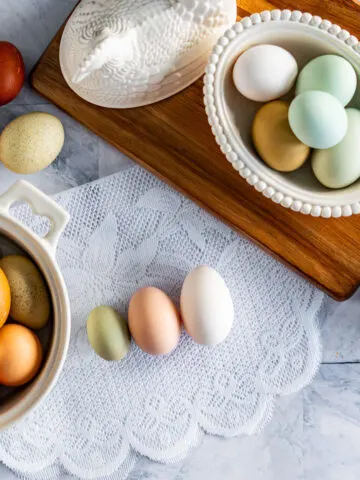For a lot of homesteaders, chickens are more than just animals — they can be an integral part of the self-sufficient lifestyle. Chickens provide us with sustenance, companionship, and entertainment.
I don’t know about you, but morning coffee with my birds is one of my favorite things!
But have you ever stopped to wonder what makes our feathered friends tick? With their wide variety of behaviors and habits, chickens are fascinating. And they bring up a lot of questions.
One that my kids asked was "Do chickens have tongues?"

As an Amazon Associate I earn from qualifying purchases.
Jump to:
- Chicken Tongues: More Than You Needed To Know!
- What Does A Chicken Tongue Look Like?
- What Is A Lingual Nail?
- Do Chickens Have Taste Buds?
- Do Chickens Have Teeth?
- What Do Chickens Use Their Tongues For?
- What Heath Issues Can Affect Your Chicken's Tongue?
- More Chicken Content!
- Pin this Do Chickens Have Tongues article!
- Comments
Chicken Tongues: More Than You Needed To Know!
Yup, you’re about to get a science lesson!
Chickens belong to the galliform family, which also includes quail, turkeys, and pheasants. All of these birds have tongues that are structured similarly, and very different than tongues you're used to seeing.

What Does A Chicken Tongue Look Like?
It's hard to describe a chicken tongue to someone who hasn't seen it because most of us lack a frame of reference! There are no other animals that I've personally encountered that have the same kind of tongue.
Chicken tongues are triangular in shape and designed to fit within the lower beak. The rough surface has hardened hairs or bumps on it, kind of like a cat's tongue - although a cat's sandpaper tongue is that way for a different reason.
They are small and pale in color, often matching the inside of the beak, and actually, pretty difficult to see if you're not up close and personal. This explains why you might be asking yourself "do chickens have tongues?".

What Is A Lingual Nail?
At the tip of the tongue, chickens have what is called a lingual nail which is a hardened keratin structure. Keratin is the same protein responsible for our hair and nails, as well as your bird's feathers and claws. In other words, it’s like a nail at the tip of the tongue and helps chickens grip their food.
Do Chickens Have Taste Buds?
Like us, chickens have taste buds on their tongue to help them differentiate the flavors of food. Chickens have around 240 and 360 taste buds scattered across their tongue and mouths.
The number of taste buds varies depending on the age of the chicken, with younger chickens having more taste buds than older ones, and even the chicken breeds or types - broiler or meat birds have more taste receptors than laying types.
If this number sounds low, that's because it is - humans have somewhere around 10, 000 taste buds!
Chickens are actually better at tasting things dissolved in water than dry additives. I wonder if this explains why they like fresh food so much. Do do chickens taste food more vividly when it has a higher water content?

The birds are actually able to discern most of the 5 taste qualities, sweet, bitter, umami, sour, and salty, but not equally. Chickens are more tolerant of sour flavors than of bitter flavor and don't really respond to sweet or salty flavors until they are higher in concentration.
That said, a chook's tongue is not its primary taste receptor because far fewer taste buds are on the tongue than in the oral cavity. Is it considered a mouth if it's a beak? I'm gonna go with the oral cavity. ha.
Although the science clearly states that they have a much smaller number of taste buds than humans and other animals, I often wonder if chickens have more potent taste buds, therefore requiring fewer of them. I mean, have you ever had your flock run to you because you've got treats in your hand?

Do Chickens Have Teeth?
So chickens have tongues and taste buds, but do they have teeth?
No. Teeth are primarily designed to kickstart food digestion by breaking food into smaller particles, but chickens use a different method for digesting food, called a gizzard. This organ is a muscular part of the digestive system that holds small stones and grit that the birds eat, which help to grind up food.
Teeth are also used to grab and tear food, when faced with an extra large bite of food, chickens peck at it with their strong beaks to break it into smaller, more edible pieces.
When chickens eat, the tongue helps to swallow food and it is directed to the crop, which is like a first stomach. In the crop, the foods are coated with a digestive enzyme to begin the breakdown, but most of the digestion occurs in the gizzard due to the mechanical grinding of the food.

What Do Chickens Use Their Tongues For?
Since they can't lavish you with puppy kisses, you might be wondering what does a chicken's tongue actually do?
Tasting:
We know now that chickens have taste buds on their tongues, and to some extent, they use their tongues to taste their food. This may be an evolutionary adaptation allowing them to taste to see if things are edible or toxic.
Swallowing:
Chickens have evolved over time so that their tongues no longer need to move food around in their mouth as much as other mammals do because of the gizzard we mentioned earlier. But that isn't to say that chickens don't use their tongues to assist with eating.
These peck-feeding birds break up large pieces and pick up food with their beaks. They must use their tongues to help move the food to the esophagus so that it can be swallowed. This is why the texture of the tongue is so important, keeping food from sliding back to the front of the beak.
If you've seen the family dog drink water you might be wondering if the chickens use their tongues to help drink, but the answer to that is no. Chickens drink by scooping water into their beak and tipping their heads back to swallow - no thanks to their tongues!

Communication:
Chickens are very social animals. They use a variety of physical and vocal cues to communicate with each other. In order to make sounds, chickens push air out of their body causing membranes to vibrate, creating noise. They can control the sound by controlling the muscles of the syrinx.
I believe, possibly wrongly, that chickens use their tongues to further fine-tune communications. The more time you spend with your chooks, the more you'll agree with me.
From roosters helping first-time layers by purring to them, to hens singing the egg song, to the constant chatter from the coop, there are so many different sounds, it would be hard to believe the tongue doesn't have something to do with it.

What Heath Issues Can Affect Your Chicken's Tongue?
Black Tongue:
Niacin deficiency in chicks can cause "black tongue". This vitamin deficiency can be prevented by feeding chickens a balanced diet with sufficient niacin. In laying hens, niacin deficiency can cause weight loss, reduced egg production, and poor hatch rates.
Fowl Pox:
The fowl pox virus is pretty foul! It causes crusty lesions on the unfeathered areas of your bird, they are often seen on the comb and waddles and look similar to chicken pox. The lesions can also affect the mouth and tongue.
More Chicken Content!
Pin this Do Chickens Have Tongues article!






Mark
Monday 4th of March 2024
Yes very important for what I term 'tongue food' lie pin size crumbs or insects which requires a combination of tongue as well as their beaks.